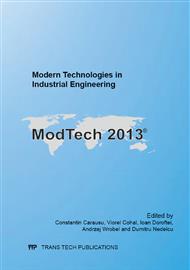p.745
p.751
p.757
p.763
p.769
p.775
p.780
p.786
p.792
Comparative Analysis of Tanker Ships Incidents and their Environment Impacts
Abstract:
The paper presents a comparative analysis of tanker ships incidents and their environment impacts. The focus is on oil tankers because this type of ships poses the highest environmental risk. By the sheer amount of oil carried, modern oil tankers can be considered a threat to the environment. In case of a maritime accident a ship can suffer fracture of the ships hull that may lead to oil outflow leading to environmental consequences or stability problems, which may again result in capsizing of the vessel. In terms of the consequences for the vessel maritime accidents can be classified in different categories. Severe accident means an accident involving a total loss of the ship, loss of life or severe pollution. Accident that is not severe which may involve: fire, explosion, stranding, collision damage caused by bad weather, damage caused by ice, fracture in the hull or suspected damage to the body. This may also lead to pollution. And incidents that are circumstances or events caused by, or related with the operation of a ship from which the ship or any person is being hazard or results in serious damage to the ship, the ship's structure or the environment. Oil spills have devastating effects on the environment. Shipping regulations have been developed or modified over years on the basis of some significant marine accidents. The regulations are mostly concentrated on reducing the consequences of maritime incidents. Following the Exxon Valdez spill, the United States passed the Oil Pollution Act of 1990 (OPA-90), which excluded single-hull tank vessels of 5,000 gross tons or more from U.S. waters from 2010 onward, apart from those with a double bottom or double sides, which may be permitted to trade to the United States through 2015, depending on their age. Following the sinkings of the Erika (1999) and Prestige (2002), the European Union passed its own stringent anti-pollution packages (known as Erika I, II, and III), which also require all tankers entering its waters to be double-hulled by 2010. Oil tankers are only one source of oil spills. Air pollution from normal tanker engines operation and from cargo fires is another serious concern. Ship fires may not only result in the loss of the ship due to lack of specialized firefighting gear and techniques but the fires sometimes burn for days and require evacuations of nearby residents due to the dangerous smoke.
Info:
Periodical:
Pages:
775-779
Citation:
Online since:
November 2013
Authors:
Keywords:
Price:
Сopyright:
© 2014 Trans Tech Publications Ltd. All Rights Reserved
Share:
Citation:


